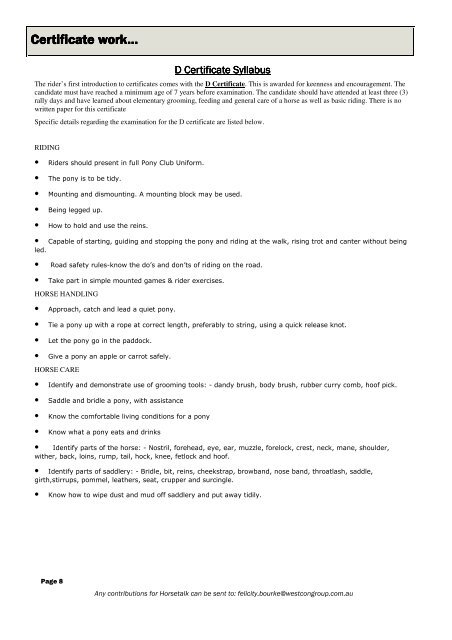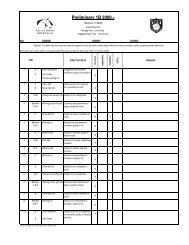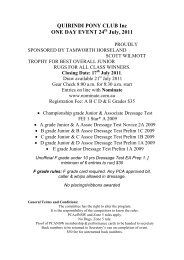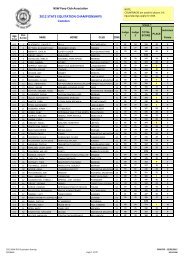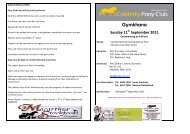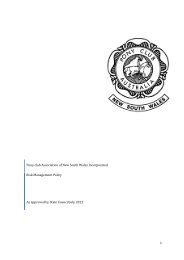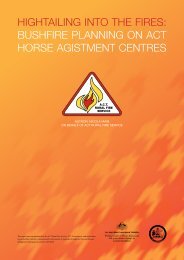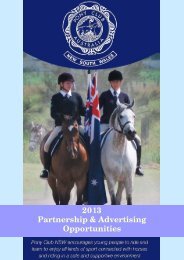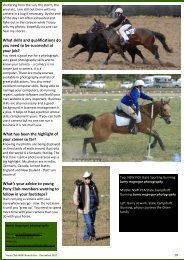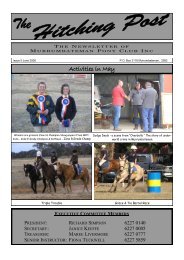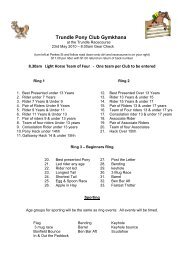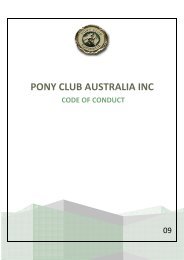Pony Club Newsletter July 2008 - Glenorie Horse and Pony Club
Pony Club Newsletter July 2008 - Glenorie Horse and Pony Club
Pony Club Newsletter July 2008 - Glenorie Horse and Pony Club
You also want an ePaper? Increase the reach of your titles
YUMPU automatically turns print PDFs into web optimized ePapers that Google loves.
Certificate work...<br />
D Certificate Syllabus<br />
The rider’s first introduction to certificates comes with the D Certificate. This is awarded for keenness <strong>and</strong> encouragement. The<br />
c<strong>and</strong>idate must have reached a minimum age of 7 years before examination. The c<strong>and</strong>idate should have attended at least three (3)<br />
rally days <strong>and</strong> have learned about elementary grooming, feeding <strong>and</strong> general care of a horse as well as basic riding. There is no<br />
written paper for this certificate<br />
Specific details regarding the examination for the D certificate are listed below.<br />
RIDING<br />
• Riders should present in full <strong>Pony</strong> <strong>Club</strong> Uniform.<br />
• The pony is to be tidy.<br />
• Mounting <strong>and</strong> dismounting. A mounting block may be used.<br />
• Being legged up.<br />
• How to hold <strong>and</strong> use the reins.<br />
• Capable of starting, guiding <strong>and</strong> stopping the pony <strong>and</strong> riding at the walk, rising trot <strong>and</strong> canter without being<br />
led.<br />
• Road safety rules-know the do’s <strong>and</strong> don’ts of riding on the road.<br />
• Take part in simple mounted games & rider exercises.<br />
HORSE HANDLING<br />
• Approach, catch <strong>and</strong> lead a quiet pony.<br />
• Tie a pony up with a rope at correct length, preferably to string, using a quick release knot.<br />
• Let the pony go in the paddock.<br />
• Give a pony an apple or carrot safely.<br />
HORSE CARE<br />
• Identify <strong>and</strong> demonstrate use of grooming tools: - d<strong>and</strong>y brush, body brush, rubber curry comb, hoof pick.<br />
• Saddle <strong>and</strong> bridle a pony, with assistance<br />
• Know the comfortable living conditions for a pony<br />
• Know what a pony eats <strong>and</strong> drinks<br />
• Identify parts of the horse: - Nostril, forehead, eye, ear, muzzle, forelock, crest, neck, mane, shoulder,<br />
wither, back, loins, rump, tail, hock, knee, fetlock <strong>and</strong> hoof.<br />
• Identify parts of saddlery: - Bridle, bit, reins, cheekstrap, browb<strong>and</strong>, nose b<strong>and</strong>, throatlash, saddle,<br />
girth,stirrups, pommel, leathers, seat, crupper <strong>and</strong> surcingle.<br />
• Know how to wipe dust <strong>and</strong> mud off saddlery <strong>and</strong> put away tidily.<br />
Page 8<br />
Any contributions for <strong>Horse</strong>talk can be sent to: felicity.bourke@westcongroup.com.au


